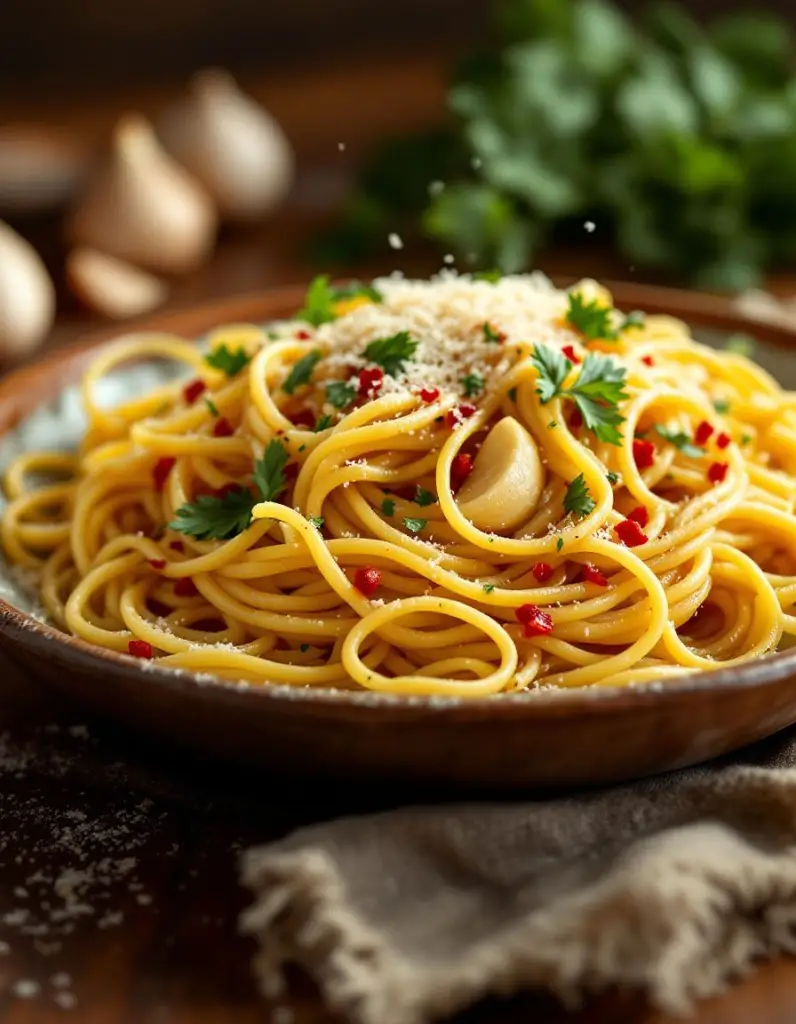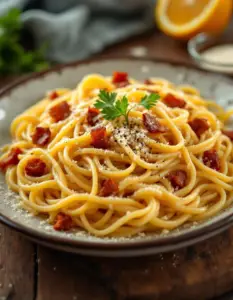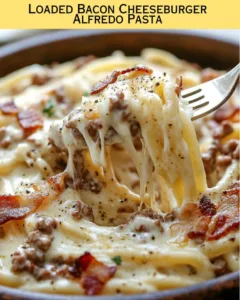Spaghetti Aglio e Olio: A Simple Yet Flavorful Delight
Indulge in the delicious simplicity of Spaghetti Aglio e Olio, a classic Italian dish that harmonizes minimal ingredients for maximum flavor. This dish, literal in its translation to “spaghetti with garlic and oil,” showcases the brilliant use of garlic, olive oil, and fresh parsley to elevate pasta into a culinary experience. The warm, fragrant blend of golden olive oil and sizzling garlic envelops each strand of spaghetti, creating a dish that is not only satisfying but also evokes a warmth reminiscent of Italian family gatherings.
With every bite, you can savor the crispness of garlic, the richness of high-quality olive oil, and the subtle hint of heat from red pepper flakes. The addition of fresh parsley adds a pop of color and a touch of freshness that enhances the overall flavor profile. Spaghetti Aglio e Olio is not just food; it’s an expression of love and tradition that brings people together around the dining table, making it perfect for weeknight dinners or special occasions.
Quick Recipe Highlights
- Flavor Profile: This dish delivers a vibrant mix of garlic’s savory notes and the grassy flavor of bright olive oil, balanced with the spice of red pepper flakes.
- Texture: Each bite of spaghetti is slightly chewy and tender, perfectly coated in a slick of oil, while the garlic adds a pleasant crunch.
- Aroma: The cooking process fills the air with the intoxicating aroma of golden browned garlic mingled with fragrant olive oil.
- Visual Appeal: The finished dish presents beautifully, adorned with a sprinkle of green parsley over glistening strands of spaghetti.
- Skill Level Needed: Ideal for beginners and experienced cooks, this recipe requires basic cooking techniques without any complicated steps.
- Special Equipment: No special tools are required; a pot for boiling pasta and a skillet for sautéing will suffice.
Recipe Overview
- Difficulty Level: Spaghetti Aglio e Olio is classified as easy due to its straightforward preparation, making it an approachable recipe for novice cooks.
- Category: This dish falls under classic Italian pasta recipes, a staple in the Mediterranean diet celebrated for its simplicity.
- Cuisine: Originating from Naples, this dish exemplifies the Italian culinary tradition of using few ingredients to create deeply satisfying flavors.
- Cost: The recipe is budget-friendly, with core ingredients that are affordable and widely available in grocery stores.
- Season: Enjoy Spaghetti Aglio e Olio year-round; its refreshing elements make it perfect for any season, particularly in warmer months.
- Occasion: Whether it’s a casual weeknight dinner or a special gathering, this dish suits any occasion with its ease and charm.
Why You’ll Love This Recipe
Taste and texture are essential in Spaghetti Aglio e Olio, which provides a delightful contrast between the rich oil and the tenderness of the spaghetti. The dish embodies comfort with each bite, making it a perfect meal to gather around after a long day. The simplicity of the ingredients means that you can make it quickly, which is perfect for busy weeknights or last-minute entertaining.
In addition to its sensational taste, there are several nutritional benefits to consider. Olive oil is packed with healthy fats that support heart health, while garlic is known for its immune-boosting properties. This dish encourages wholesome eating as it’s made from scratch, eliminating the need for processed ingredients.
Moreover, preparing Spaghetti Aglio e Olio allows you to connect with family and friends over cooking, fostering social bonds. The effortless preparation process invites everyone to join in, whether it’s chopping garlic or tossing the pasta.
The cost-effectiveness of the recipe is another appealing factor; you can create a hearty meal without breaking the bank. The ingredients are staple items in many households, which makes this dish both accessible and practical for weekly meal planning.
Finally, Spaghetti Aglio e Olio is customizable and adaptable. While the classic version is exquisite on its own, it serves as a perfect canvas for your culinary creativity. You can easily add any desired proteins or vegetables, enhancing the dish’s appeal further, proving its versatility in any kitchen.
Historical Background and Cultural Significance
Spaghetti Aglio e Olio originates from Naples, a city renowned for its rich culinary traditions. The dish represents the Italian ethos of “less is more,” highlighting how simple, high-quality ingredients can create memorable flavors. This recipe has been passed down through generations, often enjoyed as a comforting meal among families.
In Italy, pasta is more than food; it’s a cultural symbol, capturing the essence of communal dining. The act of sharing a meal of Spaghetti Aglio e Olio reflects the Italian values of togetherness, love, and appreciation for good food.
Over the years, the recipe has evolved, transcending its humble origins as a peasant dish to one celebrated in fine dining restaurants. Its adaptability allows countless variations to flourish, influenced by regional ingredients and personal preferences.
Whether enjoyed as a quick weeknight meal or served at a festive gathering, Spaghetti Aglio e Olio continues to be an integral part of Italian cuisine. This dish inspires chefs and home cooks alike to explore the beauty of simplicity in cooking while celebrating its cultural roots.
Ingredient Deep Dive
The main ingredient in Spaghetti Aglio e Olio is spaghetti, a thin, long pasta shape that perfectly captures the flavors of the sauce. Historically, spaghetti first appeared in the 12th century and has since become a staple in Italian kitchens. It is rich in carbohydrates, offering a quick energy source, and is typically made from durum wheat, which enhances its texture.
When selecting spaghetti, look for brands that list “semolina” or “durum wheat” as the primary ingredient for the best texture and taste. Store spaghetti in a cool, dry place to extend its shelf life, ensuring it remains fresh for your next culinary adventure. If you’re in a pinch, any long pasta shape can work, but cooking times may vary.
Another essential ingredient is garlic, which serves as the flavor powerhouse of the dish. With a history that dates back over 5,000 years, garlic possesses not only a strong flavor but also numerous health benefits, including anti-inflammatory properties and antioxidants that support the immune system.
To select the best garlic, choose firm bulbs with no soft spots or green shoots. Store garlic in a cool, dry location away from sunlight to prevent sprouting. If you’re out of garlic, consider using garlic powder or shallots, but keep in mind that these will alter the final flavor profile.
Common Mistakes to Avoid
- Overcooking the spaghetti: Always check the pasta for doneness a minute or two before the package instructions recommend, as it should be al dente.
- Using low-quality olive oil: The oil is a key flavor component; always use high-quality extra virgin olive oil for the best results.
- Burning the garlic: Garlic burns quickly; sauté it gently over medium heat and remove it from the heat as soon as it turns golden.
- Not reserving pasta water: Save some pasta cooking water to help adjust the sauce’s consistency; it adds starchiness and flavor.
- Adding too much heat: While a bit of spice enhances the dish, too much red pepper can overwhelm the delicate flavors of garlic and olive oil.
- Skipping the parsley: Fresh parsley adds a vital touch of color and flavor; don’t omit it from the recipe.
- Not tossing quickly: Toss the drained pasta with the garlic oil mixture immediately to ensure even coating.
- Cooking in a cold pan: Always preheat the skillet before adding olive oil to ensure even cooking of the garlic.
Essential Techniques
The most critical technique for preparing Spaghetti Aglio e Olio is properly sautéing the garlic. It forms the base flavor of the dish; therefore, it’s essential to watch it closely to avoid bitterness. Begin by heating the olive oil on medium heat and adding minced garlic, stirring constantly until it becomes golden and fragrant but not browned.
Another key technique is achieving the perfect pasta texture. Cooking the spaghetti until al dente allows it to hold its shape while absorbing the flavors of the sauce. Be sure to taste the pasta a minute before it’s supposed to be done to check for doneness. An ideal pasta should have a slight chew to it.
Pro Tips for Perfect Spaghetti Aglio e Olio
1. Use fresh ingredients: Fresh garlic and quality olive oil will elevate the dish significantly, ensuring vibrant flavors.
2. Customize the heat: Adjust the amount of red pepper flakes to match your spice tolerance, allowing everyone to enjoy the dish.
3. Experiment with herbs: Beyond parsley, consider adding fresh basil or oregano for a personal touch to the flavor.
4. Top with cheese: A sprinkle of grated Parmesan or Pecorino Romano just before serving adds a delightful umami kick.
5. Serve immediately: Spaghetti Aglio e Olio tastes best when served fresh and hot; the oils and flavors are most potent at this point.
6. Make it a one-pan meal: Add seasonal vegetables like spinach or cherry tomatoes during the last few minutes of sautéing for added nutrition.
7. Save leftover oil: Any leftover flavored oil is excellent for dressing salads or drizzling on grilled vegetables.
8. Pair with protein: Consider adding shrimp or grilled chicken for a more filling and rounded meal.
Variations and Adaptations
For a regional twist, consider preparing Puttanesca Aglio e Olio by incorporating olives, capers, and anchovies for a briny depth of flavor. During the cooler months, adding roasted vegetables, such as zucchini or bell peppers, can provide heartiness to the dish.
For those with dietary restrictions, gluten-free pasta options are widely available, allowing you to enjoy the same flavors without the gluten. Additionally, a vegan option can be achieved simply by omitting cheese while preserving the integrity of the dish.
If you’re looking to modify texture, consider toasting the spaghetti lightly before boiling—this adds a nutty flavor. Experimenting with blitzing some of the garlic to create a paste can provide an entirely different mouthfeel, enhancing the dish’s enjoyment.
When it comes to presentation, try serving the pasta in a bowl instead of on a plate for a cozy, rustic look. Top with microgreens or edible flowers for a splash of color.
Serving and Presentation Guide
When plating Spaghetti Aglio e Olio, use a large serving bowl or individual plates. Tongs or a pasta fork work well for twirling the spaghetti, creating an elegant presentation. Garnish each serving with a sprinkle of freshly chopped parsley and a light drizzle of high-quality olive oil to enhance visual appeal.
Consider pairing your pasta with crusty Italian bread served warm to mop up any remaining sauce. For a side option, a simple Arugula salad with lemon vinaigrette can provide a refreshing contrast.
Temperature is key; serve the dish immediately after preparation while it’s still hot. If making ahead of time, reheat gently in a skillet with a touch of olive oil for best results. When it comes to portion control, a typical serving size is about 75 to 100g of dry pasta per person.
Wine and Beverage Pairing
For wine enthusiasts, a crisp white wine like Pinot Grigio or a light red like Chianti pairs perfectly with Spaghetti Aglio e Olio. The acidity in these wines balances the richness of the olive oil and complements the garlic’s vibrancy.
If you prefer non-alcoholic options, consider serving sparkling water with a slice of lemon or a refreshing iced tea infused with herbs. These beverages maintain the light and fresh theme of the dish without overpowering its flavors.
Temperature is essential for wine serving; whites should be chilled to about 45-50°F, while reds are best served slightly below room temperature.
Coffee lovers might also enjoy an espresso rounded out with a dash of citrus, enhancing the flavors of the meal while providing a satisfying finale.
Storage and Shelf Life
To store leftovers, place any uneaten Spaghetti Aglio e Olio in an airtight container in the refrigerator. Proper storage can keep the dish fresh for up to three days. Make sure to cool the pasta before sealing it, preventing condensation inside the container.
Reheating can be done in a skillet over low heat. Add a splash of olive oil or reserved pasta water to help revive the flavors and prevent drying out. The microwave is also an option but may lead to uneven heating.
Freezing spaghetti is not recommended as the texture can suffer upon thawing. If needed, consider freezing the sauce separately, as garlic and oil can retain flavor well when frozen.
Watch for signs of spoilage; if the dish develops an off-smell or appearance, it’s best to discard it.
Make Ahead Strategies
For those seeking to prepare meals in advance, consider prepping garlic-infused olive oil ahead of time. This mix can be stored in the fridge for a week, allowing you to whip up the dish quickly.
Also, cooking the pasta a few hours in advance is an option. Once cooked, toss it lightly with a small amount of olive oil to prevent sticking and refrigerate. Just before serving, sauté the pre-cooked pasta with the garlic oil mixture for an easy, speedy dinner.
To maintain freshness, avoid pre-mixing everything until you’re ready to serve. This ensures that the ingredients stay vibrant and flavorful, providing the best experience when mealtime arrives.
Scaling Instructions
This recipe can effortlessly be halved or doubled based on your needs. If you halve it, simply reduce all ingredients in proportion. Ensure to scale your cookware; a smaller pot may be needed when making less, and inversely, a larger pot or skillet may be required for more.
Timing remains largely unchanged when scaling. However, keep an eye on pasta cooking time, as smaller portions may require slightly less time. Always taste-test your pasta a minute or two before the recommended cooking time to ensure perfect texture.
Keep in mind that when doubling, your skillet may become crowded, impacting the sautéing process. It’s advisable to cook in batches if necessary.
Nutritional Deep Dive
Spaghetti Aglio e Olio offers a balanced nutritional profile that includes essential macronutrients such as carbohydrates and healthy fats. The primary energy source comes from the spaghetti, while olive oil contributes beneficial monounsaturated fats that support heart health.
From a micronutrient perspective, garlic provides a wealth of vitamins like B6 and C and minerals such as manganese and selenium. Olive oil is also rich in vitamin E, an antioxidant that helps protect cells from damage.
When considering health benefits, including garlic in your diet has been linked to enhanced immune function and potential cardiovascular improvements. Additionally, making this dish at home allows for complete control over ingredients, minimizing unhealthy additives common in restaurant versions.
For those managing weight, portion control is essential. Serving sizes should ideally be around 75 to 100g of dry spaghetti, paired with a side salad to create a satisfying meal without excess calories.
Dietary Adaptations
For those needing gluten-free options, several brands now offer pasta made from rice or quinoa, which can be substituted without sacrificing flavor. Be sure to check for certified gluten-free labels to avoid cross-contamination.
Dairy-free diets can benefit from simple modifications, such as omitting cheese or substituting nutritional yeast for a cheesy flavor without dairy.
Vegans can enjoy Spaghetti Aglio e Olio as is, as it consists entirely of plant-based ingredients. For those on a low-carb or keto diet, spiralized zucchini or spaghetti squash can serve as excellent low-carb substitutes for traditional pasta.
Paleo enthusiasts can adapt the dish by using a base of sweet potato noodles or kelp noodles, keeping the meal per the eating plan.
Low-FODMAP diets can also enjoy this recipe by reducing garlic, using garlic-infused oil, or substituting with leek tops to achieve a similar flavor without triggering sensitivities.
Troubleshooting Guide
If your spaghetti becomes mushy, it’s likely due to overcooking. Always keep a close eye on cooking times, especially as the pasta nears al dente.
Should the flavor seem bland, consider adjusting the olive oil quantity or incorporating more garlic. Fresh herbs added right before serving can also enhance taste dramatically.
Temperature problems, such as your dish cooling quickly, may be remedied by serving it immediately after preparation without letting it sit too long.
If you encounter equipment challenges, like a sticky pan, ensure you are using enough oil for sautéing garlic, and allow it time to heat adequately before adding ingredients.
For ingredient substitutions, remember to taste-test for adjustments in saltiness and flavor, especially when working with pre-packaged ingredients that vary widely.
Timing concerns can also happen; if you find yourself pressed for time, prepping ingredients in advance can make a significant difference in the overall preparation speed of this dish.
Recipe Success Stories
Readers often share how Spaghetti Aglio e Olio has become a family favorite, with children enjoying its mild flavor while adults appreciate its simplicity. The dish’s accessibility has inspired many to try their hand at Italian cooking, resulting in numerous success stories.
People frequently mention their successful variations, adding seasonal ingredients like asparagus in spring or cherry tomatoes in summer, emphasizing how the basic recipe lends itself to personal touches.
Photos shared by readers showcase beautiful plating ideas, from elegant garnishes to cozy family meal setups, highlighting the dish’s versatility and appeal in various settings.
Community engagement around this recipe showcases its role in fostering connection; families who cook it together often report it becoming a cherished tradition.
Additionally, feedback emphasizes how quickly the dish can be prepared, making it a go-to solution for busy weeknights or proof of culinary creativity.
Frequently Asked Questions
Can I make Spaghetti Aglio e Olio in advance?
Yes, while fresh is best, you can prepare the garlic oil ahead of time. Simply reheat pasta quickly before serving.
What can I add to Spaghetti Aglio e Olio?
You can add various ingredients like shrimp, chicken, or roasted vegetables to enhance the dish and make it more filling.
Is Spaghetti Aglio e Olio vegan?
Yes, the traditional recipe contains no animal products, making it a great choice for vegans.
What type of olive oil should I use?
Use high-quality extra virgin olive oil for the best flavor profile. It’s worth investing in a good bottle for this recipe.
Can I use garlic powder instead of fresh garlic?
While you can use garlic powder, fresh garlic provides a much more vibrant and aromatic flavor that is essential to the dish.
How should I store leftovers?
Store leftovers in an airtight container in the refrigerator for up to three days. Reheat with a drizzle of olive oil.
Is this dish gluten-free?
To make it gluten-free, use gluten-free pasta options widely available in stores.
Can I make it spicy?
Definitely! Adjust the amount of red pepper flakes to your liking for more heat.
What is the best way to serve this dish?
Serve hot in a large bowl garnished with parsley and a drizzle of olive oil. Pair with crusty bread for a complete meal.
Can I freeze Spaghetti Aglio e Olio?
It’s not recommended to freeze spaghetti because the pasta can lose texture; however, the garlic oil can be frozen separately.
What if I don’t have parsley?
If you can’t find parsley, consider using fresh basil or even arugula for a unique flavor twist.
Additional Resources
To enhance your culinary skills further, explore related recipes like Garlic Butter Shrimp Pasta or classic Fettuccine Alfredo. For technique guides, consider reading up on pasta cooking or homemade pasta recipes to elevate your meals.
Ingredient information is crucial, so familiarize yourself with quality oils and the benefits of other fresh herbs. Finally, if you’re interested in equipment recommendations, a good pasta pot and quality knife can make all the difference in preparation.
Join the Conversation
We encourage our readers to share their experiences by posting on social media and tagging our recipe! Photographic tips go a long way in showcasing your beautiful presentations.
Be sure to leave a review on this recipe and engage with others in the comments, sharing your tips and ideas for variations. Your experiences and creativity may inspire someone else.
The Recipe
Spaghetti Aglio e Olio
Serves: 4 servings
Prep Time: 10 mins
Cook Time: 15 mins
Total Time: 25 mins
Kitchen Equipment Needed
- Large pot for boiling pasta
- Skillet for sautéing
- Large spoon or spatula for tossing
- Measuring cups and spoons
- Knife and cutting board
Ingredients
- 400g spaghetti
- 4 cloves garlic, thinly sliced
- 100ml extra virgin olive oil
- 1 teaspoon red pepper flakes (or to taste)
- Salt, to taste
- Fresh parsley, chopped, for garnish
Directions
- In a large pot of salted boiling water, cook the spaghetti according to package instructions until al dente. Reserve some pasta water before draining.
- While the pasta cooks, heat the olive oil in a skillet over medium heat. Add sliced garlic and sauté until golden, being careful not to burn it.
- Add red pepper flakes to the skillet, stirring for an additional 30 seconds to bloom the spice.
- Once pasta is cooked and drained, add it to the skillet, tossing quickly to coat the spaghetti evenly with garlic oil. If the pasta seems dry, add a splash of reserved pasta water.
- Season with salt to taste, and remove from heat. Garnish with chopped parsley before serving.
Recipe Notes
- Feel free to adjust the number of garlic cloves for a stronger or milder flavor.
- This dish can be easily doubled or halved according to your meal needs.
- For more flavor, consider adding grated Parmesan cheese before serving.










